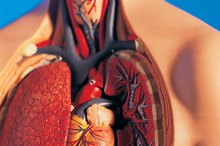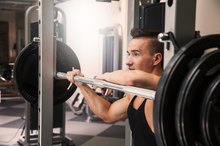Right Side Chest Pain & Exercise
Most people are familiar with chest pain as a symptom of heart attack, but many think the telltale pain is confined to the left side 3. However, chest pain before a heart attack -- especially during strenuous exercise -- can occur anywhere in the chest 3. Of course, not all chest pain signals a heart attack -- you may have heartburn, indigestion, a strained muscle or even a gall bladder issue 3. Certain lung conditions can also cause chest pain 3.
If you are experiencing serious medical symptoms, seek emergency treatment immediately.
Heartburn/Indigestion
Heartburn and indigestion are very common, and are the most likely symptoms of chest pain 3. In fact, vigorous high-impact exercise like running can trigger both conditions, especially if you've eaten too close to your workout session. The impact from the exercise jogs the gastrointestinal organs, and the blood supply gets diverted to your muscles. The result is that digestion is interrupted, and your meal "repeats" on you. Indigestion usually causes pain in the upper abdomen, and can be accompanied by belching and nausea. Heartburn produces a burning sensation in the chest and throat, and can be a cause of chronic sore throat. Antacids can help reduce the symptoms, and medications called proton pump inhibitors can be especially helpful in reliving exercise-induced symptoms by suppressing the production of acid.
- Heartburn and indigestion are very common, and are the most likely symptoms of chest pain 3.
- In fact, vigorous high-impact exercise like running can trigger both conditions, especially if you've eaten too close to your workout session.
Muscular Injury
Reduce Lung Pain After Exercise
Learn More
If you've been doing an unfamiliar exercise or strength-training your upper body, you may simply have a pulled pectoral muscle. Pain from other conditions is usually constant, no matter your position. A pulled muscle could be the culprit if the pain only occurs when you move your right arm or roll your right shoulder. Rest the muscle for a few days, applying ice as needed to control swelling. Use an over-the-counter pain reliever to reduce inflammation, and gradually return to exercise as the pain subsides. If the pain gets worse or doesn't get better within a few days, see your doctor.
- If you've been doing an unfamiliar exercise or strength-training your upper body, you may simply have a pulled pectoral muscle.
- If the pain gets worse or doesn't get better within a few days, see your doctor.
Lung Issues
People associate chest pain with the heart, but your lungs are in there too, and several lung conditions can cause chest pain 3. If you are also short of breath, wheezing and can't seem to take in enough air, you may have asthma. If you have a sharp chest pain that gets worse when you take a deep breath, pneumonia could be to blame 3. A sharp pain can also signal an inflammation of the lining around the lung, a blood clot or a collapse of a small area of your lung. Seek medical attention for any of these conditions.
- People associate chest pain with the heart, but your lungs are in there too, and several lung conditions can cause chest pain 3.
- A sharp pain can also signal an inflammation of the lining around the lung, a blood clot or a collapse of a small area of your lung.
When to See a Doctor
Why Does the Right Side of Your Chest Hurt?
Learn More
If your pain is sudden and includes a crushing pressure, radiates to your arm, jaw or back and your heart rate climbs, seek emergency medical attention. See you doctor if you have a fever, a phlegm-producing cough or problems swallowing. If you have a feeling of fullness after a greasy or fatty meal, especially if the pain is lower in the right side of your chest, you may be having a gall bladder attack, which also requires medical attention 3.
Related Articles
References
- MedlinePlus: Chest Pain
- Family Doctor: Chest Pain, Chronic
- Fu R, Li SD, Song CX, et al. Clinical significance of diabetes on symptom and patient delay among patients with acute myocardial infarction-an analysis from China Acute Myocardial Infarction (CAMI) registry. J Geriatr Cardiol. 2019;16(5):395-400. doi:10.11909/j.issn.1671-5411.2019.05.002
- Bilora F, Ceresa M, Milan M, Sarolo L, Prandoni P. The impact of deep vein thrombosis on the risk of subsequent cardiovascular events: a 14-year follow-up study. Int Angiol. 2017;36(2):156-159. doi:10.23736/S0392-9590.16.03664-6
- Bellet RN, Lamb RL, Gould TD, Bartlett HJ. Prevalence of neuro-musculoskeletal pain and dysfunction in open-heart surgical patients preoperatively and at 6 and 12 weeks postoperatively: a prospective longitudinal observation study. Pragmat Obs Res. 2017;8:211-222. doi:10.2147/POR.S131060
- National Institutes of Health, U.S. National Library of Medicine: MedlinePlus. Chest Pain. Updated August 4, 2020.
Writer Bio
Angela Brady has been writing since 1997. Currently transitioning to a research career in oncolytic virology, she has won awards for her work related to genomics, proteomics, and biotechnology. She is also an authority on sustainable design, having studied, practiced and written extensively on the subject.







